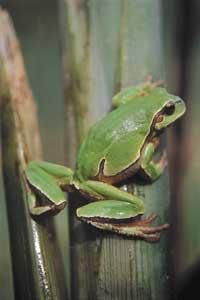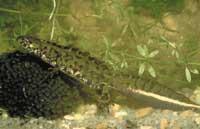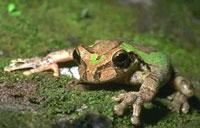By the decline of amphibians
2002/04/01 Imaz Amiano, Eneko - Elhuyar Zientziaren Komunikazioa Iturria: Elhuyar aldizkaria
On many occasions we do not know the factors that have caused the decline of populations, although they are being investigated in different areas. For example, climate change has been studied (many amphibian species spawn between 1 and 2 months earlier than many years ago). Pollution, acid rain, ultraviolet radiation, agricultural chemicals, etc., have been the subject of research on various factors.

However, most studies are timely and responsive to specific situations and it is observed that each species of amphibian responds differently to each situation. That is, it has been observed that species living in mountain ecosystems have greater protection from ultraviolet light (mechanisms of repair of damaged DNA, forms of egg protection…).
Those who worry about herpetologists, however, are not just specific situations. There is talk of a combination of reasons to explain the reduction of populations worldwide. In our latitude, the incidence of ultraviolet radiation has increased by 10% in summer and 4-5% in winter since it began to be measured. And if riverside vegetation is also eliminated, for example, the effect of radiation increases greatly. Or decreasing water levels for any reason increases the influence of radiation by disappearing depth protection.
Through mushrooms
The first response of the researchers was to study abiotic problems to explain the decline of many species, but subsequently the presence of biotic factors, more specifically male-induced amphibians, has been detected. In the USA discovered that the larvae were sick and dying. They first thought of abiotic causes, but later, in 1949, they identified the disease caused by the bacterium Aeromonas hydrophila. Subsequently, the bacterial was considered a secondary disease, since it had already been detected that iridobirus affected the diseased specimens. Now the question is why has the incidence of existing viruses increased? The increased involvement of populations with immunodeficiency and modified habitats makes researchers directly affected by the modification of abiotic factors.

Kitribere fungal infections are also becoming popular. It is a disease identified after the discovery of new species of amphibians in the most remote places in the world and a drastic decrease in populations already known in clean and protected environments within a few years. It affected the common toad in the Spanish Peñalara. It was detected in 1997 and began to be investigated in 1999, after the disappearance of the toads of 90% of the wells. They saw that they were affected.
The group of these mushrooms is very diverse and cosmopolitan, although more abundant in the puddles of the high mountains. It especially affects the specimens that have made recent metamorphosis and is very lethal (in Peñalara about 100 zoospores are enough to kill a priest in 35-47 days). Formerly it coexisted with local amphibians in balance, but in recent years (more or less since the 70s) the ostentative-pathogen balance has been broken here. In addition, it has been proven that the man (also the researchers) has taken the fungus to places where it was not, carrying spores in clothing, gloves, material… Therefore, at a congress held in Australia in 2000 several decisions were made on these fungi:
- elaboration of a working protocol with amphibians.
- Do not perform translocations or accesses.
- avoid contamination by researchers.
- disinfection of the material.
But in addition to the fact that humans have moved the disease to new places, why has the host/pathogen balance broken? This is the basic question of many research.
In general, the decline in amphibian populations is widespread. However, and despite not questioning that conviction, some say that the duration of many of the investigations that are carried out seems that it is not possible to say so. Many investigations last a year, two, three, etc., because in most cases it is difficult to find multiannual funding. However, in many cases this time period is not enough to see the trends of the populations under study, especially in areas where climate or physical environment are variable. In a study conducted in southern Spain, specifically in Murcia, 13 species were followed for 16 years. The amount of rainfall in the area is not the same each year. Thus, in the late 1980s they suffered a severe drought. In those years they were less puddles, less scarce and of less duration, and although they sang the males appeared very few females. Metamorphosis also made very few larvae. If any research on amphibians were carried out during the 3-4 years of drought, it would have been deduced that the populations of these 13 species are in full decline. Although the effect of drought is suspected, it would not be possible to know the previous and subsequent situations. However, during the 16 years that the investigation lasted, it was observed that population fluctuations were due to specific weather changes. The year following the drought it rained and, to the next, the number of amphibians increased greatly, especially that of females, and the larvae that metamorphosed that year and the following. Now, the same research team led by Manuel Tejedo is working on genetic techniques to determine whether populations are affected frequently. |

Gai honi buruzko eduki gehiago
Elhuyarrek garatutako teknologia





